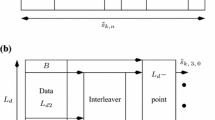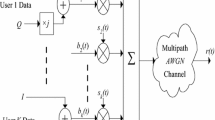Abstract
In a Dual-Rate DS/CDMA system, a primary, ``high rate'' network coexists witha secondary one with a slower rate. Demultiplexinghigh-rate users typically entails, at the receiverend, a time-varying processing ifVariable Spreading Length (VSL), Variable Chip Rate (VCR), or Variable ChipRate with Frequency Shift (VCRFS) modulation formats are used, and Rake-Typedemodulation schemes if the chip rate exceeds the channel coherence bandwidth.The realization of fully adaptive receivers thus requires the joint estimationof(a) the interference to be suppressed, whether from other users ofthe high-ratenetwork or from the secondary network, and (b) the channel tap weights.The solutionthat we consider here assumes that,for each user, a pilot signal is transmitted alongwith the information-bearing signal, whether in a time-multiplexed orin a parallel-channel format. We consider both the uplink and the downlink channel and, based on a Minimum-Mean-Square-Error(MMSE) optimality criterion, we have come up with a fully adaptive system,capable on the one handof tracking, through a cyclic Recursive-Least-Squares typealgorithm, the periodically time-varying variations of theinterference subspace andon the other of updating the channel tap weights estimates.A thorough performance assessment is presented, and the convergence dynamicsof the system are derived through computer simulations in order to assessthe impact of the prior uncertainty with regard to the other-users signaturesand thechannel tap weights realizations.
Similar content being viewed by others
References
E. Dahlman, B. Gudmundson, M. Nilsson and J. Skold, “UMTS/IMT-2000 Based on Wideband CDMA”, IEEE Personal Communications Magazine, Vol. 36, pp. 70-80, 1998.
F. Adachi, M. Sawahashi and H. Suda, “Wideband DS-CDMA for Next-Generation Mobile Communication Systems”, IEEE Personal Communications Magazine, Vol. 36, pp. 56-69, 1998.
Z. Zvonar and D. Brady, “Linear Multipath-Decorrelating Receivers for CDMA Frequency-Selective Fading Channels”, IEEE Trans. on Communications, Vol. 44, pp. 650-653, 1996.
X. Wang and H.V. Poor, “Blind Adaptive Multiuser Detection in Multipath CDMA Channels Based on Subspace Tracking”, IEEE Trans. on Signal Processing, Vol. 46, pp. 3030-3044, 1998.
A.M. Sayeed, A. Sendonaris and B. Aazhang, “Multiuser Detection in Fast-Fading Multipath Environments”, IEEE Journal on Selected Areas in Communications, Vol. 16, pp. 1691-1701, 1998.
S. Buzzi, M. Lops and A.M. Tulino, “Time-Varying Narrowband Interference Rejection in Asynchronous Multiuser DS/CDMA Systems over Frequency-Selective Fading Channels”, IEEE Trans. on Communications, Vol. 47, pp. 1523-1536, 1999.
S. Buzzi, M. Lops and A.M. Tulino, “MMSE Rake Reception for Asynchronous DS/CDMA Overlay Systems and Frequency-Selective Fading Channels”, Wireless Personal Communications, Kluwer Academic Press, Vol. 13, pp. 295-318, 2000.
U. Fawer and B. Aazhang, “A Multiuser Receiver for Code Division Multiple Access Communications over Multipath Channels”, IEEE Trans. on Communications, Vol. 43, pp. 1556-1565, 1995.
X. Wang and H.V. Poor, “Adaptive Joint Multiuser Detection and Channel Estimation for Multipath Fading CDMA Channels”, Wireless Networks, Baltzer Science Publishers, Vol. 4,No. 6, pp. 453-470, 1998.
G. Caire and U. Mitra, “Pilot-Aided Adaptive MMSE Receivers for DS/CDMA”, Proc. of the 1999 IEEE International Conference on Communications (ICC'99), Vancouver, Canada, June 1999.
H. Ge, “Multiuser Detection for Integrated Multi-Rate CDMA”, Proc. of the First International Conference on Information, Communications and Signal Processing (ICICS '97), Singapore, September 1997.
U. Mitra, “Comparison of Maximum Likelihood-Based Detection for Two Multi-Rate Access Schemes for CDMA Signals”, IEEE Trans. on Communications, Vol. 47, pp. 64-77, 1999.
A.L. Johansson and A. Svensson, “Successive Interference Cancellation in Multiple Data Rate DS/CDMA Systems”, Proc. of the IEEE Vehicular Technology Conference (VTC '95), Chicago, U.S.A., July 1995.
S. Buzzi, M. Lops and A.M. Tulino, “MMSE Multi-User Detection for Asynchronous Dual Rate Direct Sequence CDMA Communications”, Proc. of the 9th International Symposium on Personal Indoor and Mobile Radio Communications (PIMRC'98), Boston (MA), U.S.A., September 1998.
M. Lops, G. Ricci and A.M. Tulino, “Narrowband Interference Suppression in Multiuser CDMA Systems”, IEEE Trans. on Communications, Vol. 46, pp. 1163-1175, 1998.
S. Buzzi, M. Lops and A.M. Tulino, “Blind Cyclic Interference Cancellation for Overlay DS/CDMA Systems over Frequency-Selective Fading Channels”, Proc. of the 10th International Symposium on Personal Indoor and Mobile Radio Communications (PIMRC'99), Osaka, Japan, September 1999.
S. Buzzi, M. Lops and A.M. Tulino, “Partially Blind Adaptive MMSE Interference Rejection in Asynchronous DS/CDMA Networks over Frequency-Selective Fading Channels”, to appear on IEEE Trans. on Communications.
J.G. Proakis, Digital Communications, 3rd edition, McGraw-Hill: New York, 1995.
H.V. Poor and X. Wang, “Code-Aided Interference Suppression for DS/CDMA Communications — Part I: Interference Suppression Capability, Part II: Parallel Blind Adaptive Implementations”, IEEE Trans. on Communications, Vol. 45, pp. 1101-1122, 1997.
W.A. Gardner, “Cyclic Wiener Filtering: Theory and Method”, IEEE Trans. on Communications, Vol. 41, pp. 151-163, 1993.
W.A. Gardner, Statistical Spectral Analysis: A Non-Probabilistic Theory, Prentice Hall: New Jersey, 1988.
L.E. Franks, “Polyperiodic Linear Filtering”, in W.A. Gardner (ed.), Cyclostationarity in Communications and Signal Processing, IEEE Press, 1994.
Author information
Authors and Affiliations
Rights and permissions
About this article
Cite this article
Buzzi, S., Lops, M. & Tulino, A.M. Adaptive Detection and Channel Estimation for Dual-Rate DS/CDMA Networks in Frequency-Selective Fading. Wireless Personal Communications 16, 259–285 (2001). https://doi.org/10.1023/A:1008926902988
Issue Date:
DOI: https://doi.org/10.1023/A:1008926902988




